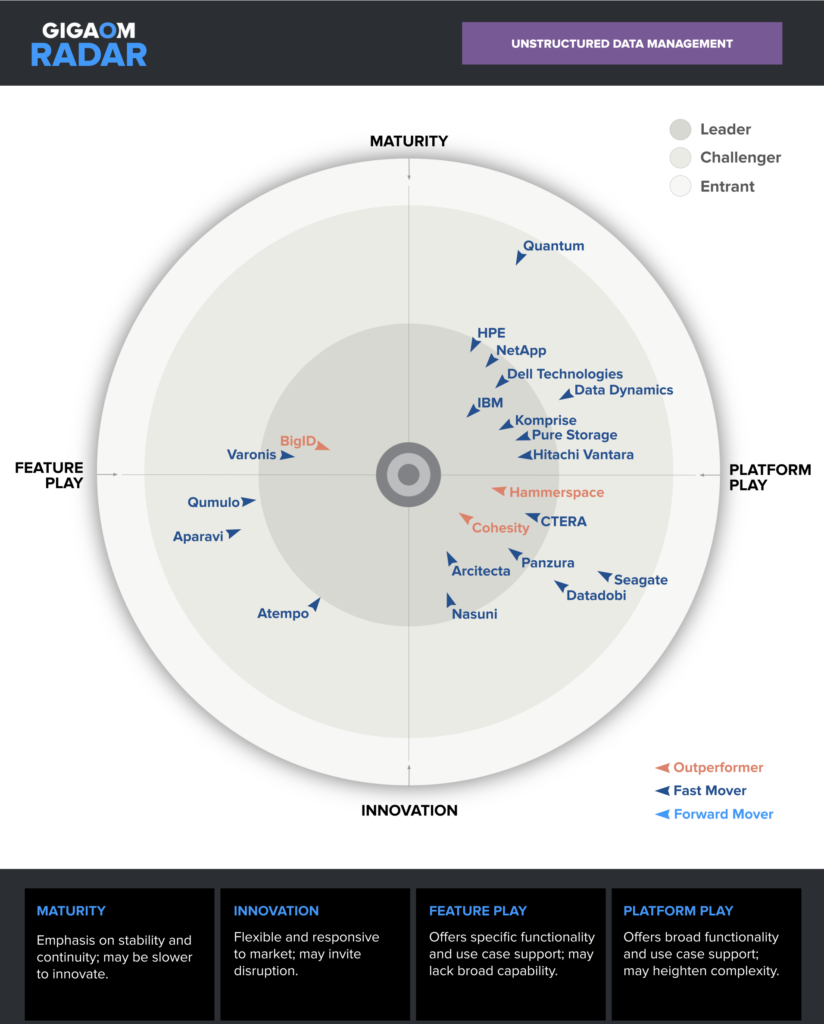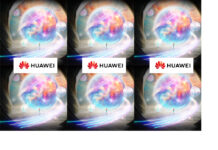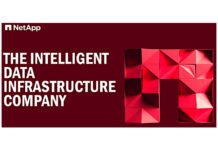Research house GigaOm has re-evaluated unstructured data management (UDM) and Storage-as-a-Service (STaaS) suppliers in updated Radar and Sonar reports.
It reviewed 22 of the top UDM vendors and the Radar report graphic locates them in a 2D concentric circular space, with an outside Entrant ring, a middle Challenger ring, and an inner Leader ring, with closeness to the central bullseye indicating a higher rating in terms of overall value. This circular space is divided into four quadrants by two orthogonal axes running through the bullseye. A horizontal one runs from Feature Play to Platform Play, and a vertical one spans a Maturity to Innovation range. The 22 suppliers are located in one of the three rings and one of the four quadrants, with colored arrows depicting the speed of their progress.
It sounds complicated, but a look at the Radar graphic provides a clear overview of the vendors’ situations and ratings:

The top-rated vendors, with averaged ratings across a key features comparison, are Arcitecta, Cohesity, and IBM, each with 4.4 out of the maximum 5 score. BigID is fourth with 4.3, Varonis fifth with 4.1, and Hammerspace and Pure Storage follow, both scoring 4.0.
In a separate business criteria comparison Arcitecta leads (4.7) followed by Cohesity and Hammerspace (4.5 each), Komprise (4.3), and Atempo, BigID, Hitachi Vantara, IBM, and Panzura (4.2 each).
Our first impression is that there are too many suppliers included, as our own list of UDM vendors includes Arcitecta, Datadobi, Data Dynamics, Hammerspace, and Komprise – just five. We wouldn’t, for example, intuitively include Hammerspace and Pure Storage in one unstructured data management market category, nor Seagate and Datadobi for that matter.
Analyst Whit Walters casts his net wide, including cloud file services suppliers CTERA, Nasuni and Panzura, general unstructured data storage suppliers such as Dell, HPE, Hitachi Vantara, IBM, NetApp, Pure Storage, and Quantum, data protector Cohesity, scale-out filer Qumulo, and HDD manufacturer Seagate, which offers the Lyve product line. Add in Aparavi and Atempo, and you have an eclectic group of 22 suppliers.
What are Walters’ criteria for inclusion? They are pretty general, as he looked at suppliers in two market segments:
- Infrastructure-focused: Solutions for this segment are designed to target data and metadata management at the infrastructure level, including automatic tiering and basic information lifecycle management, data copy management, analytics, indexing, and search.
- Business-focused: Solutions for this market are designed to solve business-related problems, including compliance, security, data governance, big data analytics, e-discovery, and so on.
The vast majority of vendors, 17, focus on providing general platforms rather than specific features. Nine are rated as more mature than innovative, with eight being rated the opposite way.
There are two mature feature players, Varonis and BigID, and three innovative feature players, Atempo, Aparavi, and Qumulo.
Walters examined two emerging features, AIOps and Model Training, as well as Generative AI for Data Management. HPE scored highly here, with a 4.5 average score, while BigID, CTERA, Dell, and Nasuni each scored a 4.
A second GigaOm Sonar report by analyst James Brown reviews STaaS suppliers, and looks at a smaller group of ten vendors. They are located in what looks like the bottom half of a Radar diagram:

The analyst tells us: “The GigaOm Sonar provides a forward-looking analysis of vendor solutions in a nascent or emerging technology sector. It assesses each vendor on its architecture approach (Innovation) while determining where each solution sits in terms of enabling rapid time to value (Feature Play) versus delivering a complex and robust solution (Platform Play).”
“The GigaOm Sonar chart plots the current position of each solution against these three criteria across a field of concentric semicircles, and solutions set closer to the center are judged to be of higher overall value. The forward-looking progress of vendors is further depicted by arrows that show the expected direction of movement over a period of 12 to 18 months.”
The vendors are spread fairly evenly across this space, with Infinidat leading overall, followed by NetApp, Pure Storage, and then HPE. Challengers are led by Zadara, Dell, and Hitachi Vantara.
Given that Backblaze and Wasabi are included, it raises the question of why AWS, Azure, and Google Cloud are absent. We have asked GigaOm for clarification ad James Brown told us: “The exclusion of AWS, Azure, and Google Cloud from the STaaS report is due to their foundational role in defining the Storage as a Service market, as STaaS is a core component of their established Infrastructure as a Service offering. Including these market giants would likely skew the report’s findings, potentially overshadowing emerging or niche STaaS providers who offer specialized solutions or target distinct market segments. The report focuses on evaluating providers that offer unique value propositions beyond standard object, block, and file storage, such as specialized storage for specific workloads, enhanced data management features, or on-premises and hybrid solutions. These vendors often serve as the benchmark against which other providers are measured, rather than being evaluated themselves.”
GigaOm subscribers can access both reports through their subscriptions.








